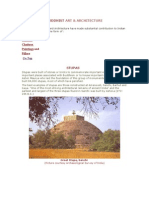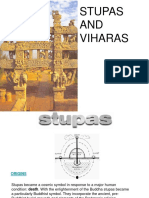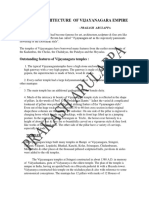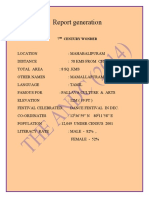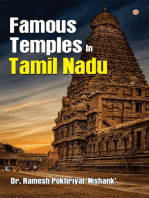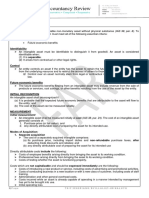Pal Lava
Pal Lava
Uploaded by
Shruthi ArCopyright:
Available Formats
Pal Lava
Pal Lava
Uploaded by
Shruthi ArCopyright
Available Formats
Share this document
Did you find this document useful?
Is this content inappropriate?
Copyright:
Available Formats
Pal Lava
Pal Lava
Uploaded by
Shruthi ArCopyright:
Available Formats
The Badami Chalukya architecture was a temple building idiom that evolved in the time period of 5th 8th
h centuries AD. in the area of Malaprabha basin, in present day Bagalkot district (North Karnataka) of Karnataka state. Vesara style and Chalukya style. Their earliest temples date back to around 450 in Aihole when the Badami Chalukyas were feudatories of the Kadamba of Banavasi. BADAMI Cave 1 (Shiva) Cave 2 (Vishnu as Trivikrama or Vamana, Varaha and Krishna) Cave 3 (Vishnu as Narasimha, Varaha, Harihara and Trivikrama.) Cave 4 (Jain Tirthankara Parsvanatha) Bhutanatha group temples (Badami and Kalyani Chalukya) Mallikarjuna group temples (Kalyani Chalukya) Yellamma group temples (Kalyani Chalukya) During 450 AD, the Chalukya style originated in Aihole and was perfected in Badami and Pattadakal. The Chalukya artists experimented with different styles,blended the Indo-Aryan Nagara and Dravidian styles, and evolved Chalukya style. The equals of the grand temples of South India do not find in North and Central India, (which was comparatively free of frequent foreign invasions). Their style includes two types of monuments. The rock cut halls (caves) - Badami Structural temples Aihole andPattadakal Badami cave temples have rock cut halls with three basic features: pillared veranda, columned hall and a sanctum cut out deep into rock. Early experiments in rock cut halls were attempted in Aihole where they built three cave temples, one each in Vedic, Buddhist and Jaina styles. Later they refined their style and cut out four marvellous cave temples at Badami. One noteworthy feature of these cave temples is the running frieze of Ganas in various amusing postures caved in relief on each plinth. The outside verandas of the cave temples are rather plain, but the inner hall contains rich and prolific sculptural symbolism. Many centuries later, the serene art of the Badami Chalukya reappeared in the pillared architecture of the Vijayanagar Empire. Their caves include finely engraved sculptures of Harihara, Trivikrama, Mahisa Mardhini, Tandavamurthi, Paravasudeva, Nataraja, Varaha, Gomateshvara and others.
Pallava architecture classified into: 1st phase : wholly rock-cut 2nd phase : wholly structural Rajasimha brought a new architectural movement: rock cut movement ceased & art of structural building taken up. 2 main e.g. Of Rajasimha groupthe Kailasanatha temple &The Vaikuntha perumal temple in Kanchipuram. The Seven Rathas were excavated during the reign of Narasimhavarman 1. The Dharmaraja Ratha is the largest of the group and is 12.8 mtrs. long. Its height is 12.3 mtrs feet. Built on a square base, it has a 3-tier pyramidal superstructure with a stupa adorn it on top. The Draupadi Ratha is the smallest and most elegant. Dedicated to Saivism, these rathas have around them images of lions, elephants and bulls carved on rocks as symbols of Durga, Indra and Shiva respectively.
The temples, mostly pyramidal structures have either a square or rectangular base. The superstructure of the Bhima Ratha is different and is semicircular in shape like the vaulted roof of a wagon. The mandaps and Rathas are adorned with beautiful sculptured figures and panels. Pancha Rathas (Five Chariots) - five monolithic pyramidal structures named after the Pandavas (Arjuna, Bhima, Yudhishtra, Nakula and Sahadeva) and Draupadi. An interesting aspect of the rathas is that, despite their sizes they are not assembled each of these is carved from one single large piece of stone. Arjuna's Penance - relief sculpture on a massive scale extolling an episode from the Hindu epic, The Mahabharata. Descent of the Ganges - a giant open-air bas relief. The Shore Temple - a structural temple along the Bay of Bengal with the entrance from the western side away from the sea. Recent excavations have revealed new structures here
You might also like
- Master Sheets TaxDocument24 pagesMaster Sheets TaxabdullahNo ratings yet
- Business of Cancel Culture Study: 2021 Porter NovelliDocument24 pagesBusiness of Cancel Culture Study: 2021 Porter NovelliSakshiNo ratings yet
- Temple of DeccanDocument30 pagesTemple of Deccanjagannath sahaNo ratings yet
- Milestone 09 - Wireframes and Prototype Submission - EXAMPLEDocument4 pagesMilestone 09 - Wireframes and Prototype Submission - EXAMPLEhz zinNo ratings yet
- Unit 4 Dravidianarchitecture 160614134901 Pages 1 54Document54 pagesUnit 4 Dravidianarchitecture 160614134901 Pages 1 54Sheshu SheshadriNo ratings yet
- The Chalukayan Architecture: Submitted By: PANKAJ AR-1402 Epsha Ar-1423 SANCHIT AR-1424 Amit Ar-1433Document17 pagesThe Chalukayan Architecture: Submitted By: PANKAJ AR-1402 Epsha Ar-1423 SANCHIT AR-1424 Amit Ar-1433nikitaNo ratings yet
- B1.Evolution of TemplesDocument12 pagesB1.Evolution of TemplesAbhay SharmaNo ratings yet
- Unit 4 Dravidianarchitecture 160614134901 PDFDocument108 pagesUnit 4 Dravidianarchitecture 160614134901 PDFRatika100% (1)
- Early Temples in BadamiDocument9 pagesEarly Temples in BadamiSanjay KumarNo ratings yet
- Dravidian Temple and Indo-Aryan TempleDocument34 pagesDravidian Temple and Indo-Aryan TempleShivani Snigdha100% (1)
- No Ram in Khmer TemplesDocument22 pagesNo Ram in Khmer TemplesUday DokrasNo ratings yet
- HINDUISMDocument10 pagesHINDUISMshirin subaidaNo ratings yet
- Dravida Temple Architecture FeaturesDocument17 pagesDravida Temple Architecture FeaturesRama BaiNo ratings yet
- MODULE II - Temple Architecture of Southern India Evolution of Dravida TemplesDocument80 pagesMODULE II - Temple Architecture of Southern India Evolution of Dravida TemplestanirikabiswasNo ratings yet
- History of Architecture Notes On Indian HistoryDocument20 pagesHistory of Architecture Notes On Indian HistoryAkhilSharmaNo ratings yet
- Pallava StyleDocument30 pagesPallava StyleSamudrala SreepranaviNo ratings yet
- Agama Shilpa Parampara 2Document9 pagesAgama Shilpa Parampara 2Prantik GuptaNo ratings yet
- Indian Temple Architecture: Devanshu .D. Veshviker Roll No. 65 Submitted To-Bharti Teacher Class - 10 - CDocument30 pagesIndian Temple Architecture: Devanshu .D. Veshviker Roll No. 65 Submitted To-Bharti Teacher Class - 10 - CShiwangi NagoriNo ratings yet
- Rock Cut ArchitectureDocument7 pagesRock Cut ArchitecturetejaswaniNo ratings yet
- Rathas of MahabalipuramDocument12 pagesRathas of MahabalipuramIpshita verma100% (4)
- Introduction :historyDocument26 pagesIntroduction :historyabhasjha19No ratings yet
- Vimana: DR Uday Dokras PHD SwedenDocument17 pagesVimana: DR Uday Dokras PHD SwedenudayNo ratings yet
- Temple Architecture in India Early Cave TraditionsDocument13 pagesTemple Architecture in India Early Cave TraditionsRama BaiNo ratings yet
- The Chola DynastyDocument4 pagesThe Chola DynastyIshitaNo ratings yet
- Shore Temple of Mamallapuram, IndiaDocument3 pagesShore Temple of Mamallapuram, IndiaCess SoronioNo ratings yet
- The Temple Architecture Styles in IndiaDocument9 pagesThe Temple Architecture Styles in IndiaArun SharmaNo ratings yet
- Chaityas and ViharasDocument14 pagesChaityas and ViharasAswani BhupathiNo ratings yet
- Cvac-Iksa Unit-Iii Q&a - 240718 - 152029Document6 pagesCvac-Iksa Unit-Iii Q&a - 240718 - 152029anduse347No ratings yet
- Indian ArchitectureDocument39 pagesIndian ArchitectureAnnie Varghese100% (3)
- Pallava Art and ArchitectureDocument11 pagesPallava Art and ArchitectureJuan Felipe RodríguezNo ratings yet
- Dravidian ArchitectureDocument25 pagesDravidian ArchitectureArun Unnikrishnan100% (3)
- DR K MangayarkarasiDocument5 pagesDR K MangayarkarasiGeerthana ArasuNo ratings yet
- Rock-Cut Architecture Is The Creation of StructuresDocument25 pagesRock-Cut Architecture Is The Creation of StructuresIshikaNo ratings yet
- Stupas AND ViharasDocument17 pagesStupas AND ViharasAADIL AHMED ANo ratings yet
- Stupas 100211074024 Phpapp01Document17 pagesStupas 100211074024 Phpapp01AADIL AHMED ANo ratings yet
- Khajuraho Temple (Kandariye Mahadev Temple)Document4 pagesKhajuraho Temple (Kandariye Mahadev Temple)Ramji RaoNo ratings yet
- 11 04 07Document88 pages11 04 07Debanjali SahaNo ratings yet
- Special StudyDocument42 pagesSpecial StudyShívã Dúrgèsh SDNo ratings yet
- Ar22-15 History of Architecture IDocument8 pagesAr22-15 History of Architecture ItrialsforopenNo ratings yet
- 80 RecommendationDocument13 pages80 Recommendationcrmm1961No ratings yet
- History Sec Assignment: Introduction To Art in Indian SubcontinentDocument7 pagesHistory Sec Assignment: Introduction To Art in Indian SubcontinentAashi SharmaNo ratings yet
- Important Temple in IndiaDocument9 pagesImportant Temple in IndiaMd Khurshid AnsariNo ratings yet
- 13 - Chapter 4 - 2Document31 pages13 - Chapter 4 - 2AahahaNo ratings yet
- Chapter - 1Document8 pagesChapter - 1crmm1961No ratings yet
- Temple Architecture Styles in IndiaDocument13 pagesTemple Architecture Styles in IndiaPrakhyati SharmaNo ratings yet
- Indian Architecture: Presented By: Kim Molina Maisie RiveraDocument125 pagesIndian Architecture: Presented By: Kim Molina Maisie RiveraAndrew AmedaNo ratings yet
- Comparison of The Design of Prasat Auk Um and The 11 TH Century Baphuon With Masrur Temple IndiaDocument11 pagesComparison of The Design of Prasat Auk Um and The 11 TH Century Baphuon With Masrur Temple IndiaUday DokrasNo ratings yet
- Whole Subsequent of Not Only India Borders". StrongDocument9 pagesWhole Subsequent of Not Only India Borders". StrongAsh ShuklaNo ratings yet
- ROCK Temple ArchitectureDocument28 pagesROCK Temple ArchitectureUday DokrasNo ratings yet
- 1617445341-9. Early Medieval (Part-2)Document12 pages1617445341-9. Early Medieval (Part-2)Nikhil JhajjaryNo ratings yet
- Temple ArchitectureDocument28 pagesTemple Architectureakileshmathan2007No ratings yet
- Art & Culture 04 - Daily Class NotesDocument24 pagesArt & Culture 04 - Daily Class NotesAkhanksyaNo ratings yet
- Chalukyan Temple ArchitectureDocument33 pagesChalukyan Temple ArchitectureAyush GuptaNo ratings yet
- The Styles of Temple Architectur EDocument27 pagesThe Styles of Temple Architectur EAnshika sainiNo ratings yet
- Content: Mauryan Period 4 Post Mauryan 5 Gupta Period 6 Post Gupta Period 7 Delhi Sultanate 9 Mughal Period 10Document9 pagesContent: Mauryan Period 4 Post Mauryan 5 Gupta Period 6 Post Gupta Period 7 Delhi Sultanate 9 Mughal Period 10rahu69No ratings yet
- BuddhistDocument16 pagesBuddhistGayathri BalanNo ratings yet
- Rock Cut ArchitectureDocument6 pagesRock Cut ArchitectureKamal JajoriyaNo ratings yet
- Art and Architecture of Vijayanagara EmpireDocument4 pagesArt and Architecture of Vijayanagara Empireray mehtaNo ratings yet
- Indian Art and Culture 2 Manuj Jindal IAS AIR 53Document16 pagesIndian Art and Culture 2 Manuj Jindal IAS AIR 53Trial UserNo ratings yet
- Report Generation: 7 Century WonderDocument15 pagesReport Generation: 7 Century WonderAkshayahNo ratings yet
- Architecture: Early&ClassicalDocument38 pagesArchitecture: Early&ClassicalSanjay KumarNo ratings yet
- Famous Temples in Tamil NaduFrom EverandFamous Temples in Tamil NaduRating: 5 out of 5 stars5/5 (1)
- Wallmob Pos Manual Backoffice OkDocument25 pagesWallmob Pos Manual Backoffice OkSatyaNo ratings yet
- Unidad 1 y 2Document27 pagesUnidad 1 y 2Johanna CorreaNo ratings yet
- Esmeralda, OperaDocument2 pagesEsmeralda, OperaNicholas GoriNo ratings yet
- Trial K1 Matematik SPM 2024 - Johor_JB SET 1Document8 pagesTrial K1 Matematik SPM 2024 - Johor_JB SET 1pirateezhjNo ratings yet
- Window To World History Teachers Guide - Grade 7thDocument44 pagesWindow To World History Teachers Guide - Grade 7thFarah Shujaat100% (3)
- DBG 718 Ambuclao RD. LAMUT, BL209: Representational ArtDocument2 pagesDBG 718 Ambuclao RD. LAMUT, BL209: Representational ArtDANIELA GALINGAN100% (1)
- Sociology AssignmentDocument5 pagesSociology Assignmentmusaligalla dileepNo ratings yet
- Reality and Fiction in The Novels of GaldósDocument26 pagesReality and Fiction in The Novels of GaldósnadiaNo ratings yet
- Fnri Facts&Figures2011Document347 pagesFnri Facts&Figures2011Kristine S. Romorosa-Galamgam100% (1)
- Timeline & Chronological Matrix_PlanninTimeline & Chronological Matrix_Planning Cities AndTimeline & Chronological Matrix_Planning Cities AndTimeline & Chronological Matrix_Planning Cities AndTimeline & Chronological Matrix_Planning Cities AndTimeline & Chronological Matrix_Planning Cities AndTimeline & Chronological Matrix_Planning Cities AndTimeline & Chronological Matrix_Planning Cities AndTimeline & Chronological Matrix_Planning Cities AndTimeline & Chronological Matrix_Planning Cities AndTimeline & Chronological Matrix_Planning Cities AndTimeline & Chronological Matrix_Planning Cities AndTimeline & Chronological Matrix_Planning Cities AndTimeline & Chronological Matrix_Planning Cities AndTimeline & Chronological Matrix_Planning Cities AndTimeline & Chronological Matrix_Planning Cities AndTimeline & Chronological Matrix_Planning Cities AndTimeline & Chronological Matrix_Planning Cities AndTimeline & Chronological Matrix_Planning Cities AndTimeline & Chronological Matrix_Planning CiDocument33 pagesTimeline & Chronological Matrix_PlanninTimeline & Chronological Matrix_Planning Cities AndTimeline & Chronological Matrix_Planning Cities AndTimeline & Chronological Matrix_Planning Cities AndTimeline & Chronological Matrix_Planning Cities AndTimeline & Chronological Matrix_Planning Cities AndTimeline & Chronological Matrix_Planning Cities AndTimeline & Chronological Matrix_Planning Cities AndTimeline & Chronological Matrix_Planning Cities AndTimeline & Chronological Matrix_Planning Cities AndTimeline & Chronological Matrix_Planning Cities AndTimeline & Chronological Matrix_Planning Cities AndTimeline & Chronological Matrix_Planning Cities AndTimeline & Chronological Matrix_Planning Cities AndTimeline & Chronological Matrix_Planning Cities AndTimeline & Chronological Matrix_Planning Cities AndTimeline & Chronological Matrix_Planning Cities AndTimeline & Chronological Matrix_Planning Cities AndTimeline & Chronological Matrix_Planning Cities AndTimeline & Chronological Matrix_Planning CiLariza Lopega100% (1)
- DraftTR103684v004 PublicDocument90 pagesDraftTR103684v004 PublicpadoNo ratings yet
- Assignment On: British Culture: Corse Code: BBA 0306 Corse Title: International BusinessDocument11 pagesAssignment On: British Culture: Corse Code: BBA 0306 Corse Title: International BusinessShikder FaysalNo ratings yet
- ROKLive 2020 - NT06 - The Next Phase of The ITOT Integration - Extending IT Security To The CellArea Zone of The Plant ArchitectureDocument31 pagesROKLive 2020 - NT06 - The Next Phase of The ITOT Integration - Extending IT Security To The CellArea Zone of The Plant Architecturemika cabelloNo ratings yet
- (Douglas Ramage) - Politics - in - Indonesia - Democracy, Islam and The Ideology of ToleranceDocument197 pages(Douglas Ramage) - Politics - in - Indonesia - Democracy, Islam and The Ideology of ToleranceDayat LaodengkoweNo ratings yet
- Mass Beauty and Personal Care in VietnamDocument10 pagesMass Beauty and Personal Care in VietnamYenNo ratings yet
- Sony CSRDocument15 pagesSony CSRHemal Patel100% (1)
- WEIHENG Company Brochure-CompressedDocument28 pagesWEIHENG Company Brochure-CompressedRik van OijenNo ratings yet
- Moa - 4PS GardeningDocument4 pagesMoa - 4PS GardeningCarlota TejeroNo ratings yet
- East Lothian: CouncilDocument43 pagesEast Lothian: CounciltheredcornerNo ratings yet
- Zoning Aff PDFDocument1 pageZoning Aff PDFRoque M. RiveralNo ratings yet
- FAR04-06 - Intangible AssetsDocument12 pagesFAR04-06 - Intangible AssetsAi NatangcopNo ratings yet
- Antanov Jet System QuestionsDocument6 pagesAntanov Jet System QuestionsSarthak RastogiNo ratings yet
- Application FormDocument3 pagesApplication Formrajikul islamNo ratings yet
- Characteristic of RupaDocument1 pageCharacteristic of RupasusworchanNo ratings yet
- Internship Project Report - Nabeel Tahir SiddiquiDocument91 pagesInternship Project Report - Nabeel Tahir SiddiquiPayalNo ratings yet
- Utilitarianism - and - Vegetarianism CrispDocument9 pagesUtilitarianism - and - Vegetarianism CrispAuteurphiliaNo ratings yet
- Argument EssayDocument5 pagesArgument Essayapi-575341156No ratings yet


























